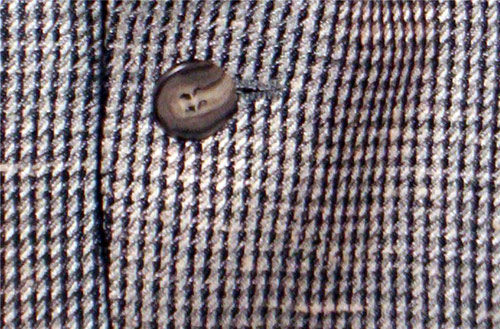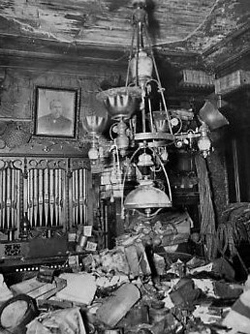For more about Gay Haubner’s life in the North Country, read the other chapters in her serialized memoir.
The Cape Cod vacation of drinking, solo hiking, and free fish was over; I was back at work. I fretted over my imprisonment in my secretarial fishbowl and tried to figure out a way to escape to the editorial side of Viva. The insanity of my chocolate article — an article both the advertising saleswomen and the editorial staff hated, an article about candy only one percent of the world could afford, an article written by a secretary — was a Hershey’s miniature of the insanity that Viva was at the time, a mashup of Vogue, Playgirl, and Ms.
The imaginary reader of Viva was a young woman with an unlimited budget for clothes and makeup (not to mention chocolates), who enjoyed sex with a wide variety of partners and without a shred of guilt, with literary taste that ran to Alice Munro and Joyce Carol Oats and who was a card-carrying leftie. I’d love to meet that girl. She’d be my new best friend.
The editors were on a mission to put Viva on the side of the angels, feminist angels anyway, with serious articles about the Equal Rights Amendment, sexism around the world, and profiles of firebrand women’s libbers.
This antidote to Viva’s penis problem (an experiment with the full Monty that did not end soon enough) was like grabbing the wheel of a car headed off a cliff and yanking it as far to the other side as possible, no matter what was there. Their concept of the Viva reader was the female equivalent of the man who supposedly bought Playboy for the articles, a reader so enthralled with the feminist content that she could ignore the gauzy photos of entwined lovers caught in the act, the ads for Penthouse, and the tips on how to make your boobs look bigger.
The sex advice column was replaced with features on notable but forgotten women in history, called, of course, “Her Story.” I managed to corner Viva editor Gini in the art department after days of bird-dogging her, toting around a tome on the French Revolution.
“Gini, have you heard of Madame Roland?” I asked and showed her an engraving of one of the most important thinkers and salon hostesses of the French Revolution; the engraving portrayed Madame Roland bravely ascending the steps of the guillotine (sent there by her male oppressors).

Rowan Johnson, Viva’s art director, looked over and realized that here was camera-ready art and therefore one less thing for him to do: “Yeah, Madame Rolaid, everyone’s heard of her, she’s famous in South Africa,” he said, and toddled off to lunch.
Gini gave her grudging consent to yet another secretary-written article, and I had my second byline in Viva. And despite my bad reputation as a mere secretary and a fake Pet, I began to worm my way into the good graces of the Viva staff.
Except for the fearsome Anna Wintour, the fashion editor. Kathy Keeton once asked me to deliver some notes about the fashion pages to Anna Wintour. I tiptoed up to her always closed office, thinking “Thar be dragons here.” To my surprise, my tentative knock (I was going to rap softly once and then dash back to my cubicle) was answered by a cracking of the door and a sliver of Anna Wintour’s face appeared, the part with the nose she looked down on me with. “Yes?”
I apologized for having to interrupt Miss Wintour with written instructions from our boss. Anna responded with an expression telegraphing no, she could not possibly read anything written by such a person as a South African. I backed off, curtsying my way down the hall, when she said, “I have this jacket,” and stuck her right hand out the crack of the door, holding on the crook of her index finger a brown and ivory houndstooth. “Maybe you would like it. I was going to give it to my maid.” It was an Yves St. Laurent and I wore it wore for twenty years.

I had barely snatched up the jacket when Anna shut the door on my face. I slipped Kathy’s hand-written pages under the door and immediately heard the rustling of paper being trod on by high heels.
(In 1979 after the tax break ended and Viva shut down, we broke into Anna Wintour’s office. It was a treasure trove — racks of designer clothes, shoes, and handbags, and bins of cosmetics, lotions, and perfume. The stuff was piled to the ceiling, as if the Collyer brothers had been fashion victims. It was a fluke that Anna had given me that Saint Laurent jacket, as apparently she never parted with as much as a lipstick.)

By the time I got back to Miss Keeton, she had forgotten about her notes to Anna Wintour and was in the grip of a brainstorm:
“Gay, get me Gini and that beauty woman, Suzanna. Oh, and…Anna Wintour” here Kathy looked off in the air, as if trying to will Anna Wintour to appear.
I was not about to go back to the lioness’s den.
“Miss Keeton, I just dropped your notes off. Anna wasn’t available.”
Kathy sighed, out of relief or frustration, I couldn’t tell. “Well fetch that round-faced girl who works for her.” That would be Georgia Gunn, Anna Wintour’s lackey and a lovely person.
Once I gathered everyone in Miss Keeton’s office, I headed back to my fishbowl.
“Wait Gay,” commanded Kathy. “I want you to stay.”
Was this it? Was I being promoted to the editorial staff?
Kathy spoke slowly as if announcing the discovery of the double helix. “Viva…is…going…to…”
Run recipes? Go back to naked men? Shut down completely?
“Do a makeover.” Kathy sat back and awaited the accolades. I was the only one who beamed and smiled; nobody in that room had the nerve to tell Miss Keeton that even in 1978, the makeover was not a new idea; women’s magazines had traded for years in the ugly duckling business.
“Two actually. We’ll makeover Gay,” she ordered, pointing at that insignificant person badly in need of a haircut who was standing in the back, arms full of page proofs, mouth hanging open. “And that little brunette girl of Rowan’s” meaning the art director’s assistant, Wanda DiBenedetto. And that was all; we were dismissed to carry out Kathy’s demands.
A week later I had a day off from my secretarial fishbowl and telephoning perverts, a day spent in a photo studio being transformed from frumpy and cheerful to Green Steel. The new me looked like a sawed-off villainess in a made-for-TV spy movie.
After loading about ten pounds of slap on my face, the makeup artist finished her work by smearing on a lipstick the exact shade of my outfit: a gold satin shirt and matching knickers. After a costume change, the makeup woman was called on again to brush contour shadow on my chest, in a bootless attempt to make it appear that I had two real breasts under the man-tailored jacket.
I tried not to take those gold satin knickers personally. Georgia Gunn told me Anna Wintour had been so offended by the trite, hackneyed, boring makeover idea that she had refused to take any part in it. Plus it was not being shot in Marrakech or Tahiti.
Georgia, caught between Kathy Keeton and Anna Wintour, Scylla and Charybdis, brought the clothing to the shoot, threw it in our direction, and spent the rest of the time hiding in a corner.


The day after my makeover shoot, Stephanie Coombs announced her resignation; she had landed a book contract and was on her way to becoming a full-time writer. Hoping that I was still basking in the twinkle of the diamond bracelet, I approached Miss Keeton on bended knee and asked for the now-open assistant editor position. I got it.
That issue of Viva, where I was transformed into a cut-rate Morgan Fairchild, was where my name first appeared on the editorial masthead.
My freelance for Oui prepared me for my slight responsibilities as assistant editor. Like Oui, Viva ran 10-12 short pieces in the front of the magazine promoting new books, music, places to go, things to eat, stuff to put on your hair, face, and body — except for “NO CLOTHES” as decreed by Anna Wintour; she would have had my guts for gaiters if I encroached on her fashion kingdom by so much as a hat pin.
I also accommodated the despondent Viva ad saleswomen, further befuddling the Viva reader by plugging cameras — “The Single Lens Reflex for the Single Girl,” stereo equipment — “Speakers for the House,” cheap foreign cars — “Drive Him Crazy,” and booze — “Cocktail Tease,” lifting copy directly from press releases and hoping I’d find a Technics turntable or a bottle of Galliano or a small Subaru delivered to my desk as my reward.
My goal was to get free stuff. I had barely got to taste the chocolaty fruits of my original Viva article. The first things I wrote as a real editor, even if only an assistant one, was on Viva letterhead to record companies telling them that my new position would include music reviews. The albums duly arrived, as did the occasional pair of concert tickets. Haircuts and manicures cost me only tips, because I wrote about new styles and trends from NYC’s “top” salons — the salons that colored my hair and scraped my foot calluses for free.
Whatever was fashionable in beauty, food, music, nightlife, Viva’s readers found in my little section, “Tattler,” three months after it had already passed out of style in New York City.
Become a Saturday Evening Post member and enjoy unlimited access. Subscribe now




Comments
Yup yup yup. Had a major crush on Wanda and Georgia. Good for me.
Sorry the article you did on ‘Haut Chocolate’ was such a bust with with both editorial and the ad saleswomen. I’m sure it was well written, and the previous was more about everyone there worrying about the deep trouble that VIVA was in at the time.
Even though the magazine was on the way down, you remarkably seemed to be on the way up with the 2nd major feature on Madame Roland.
Anna Wintour is outrageous. Barely opening her office door, she unexpectedly gives you a vintage Houndstooth jacket at the end of her index finger before promptly shutting it. You then must push Kathy’s important papers under the door to which she promptly stomps and punctures them with her high heels. There’s a lot going on there, and I best leave it at that.
Kathy’s makeover idea/order isn’t to my liking either. It’s interesting as a one-off lark you’d see a model wearing on the runway, but not a woman in real life. It reminds me of a concept car that’s really ‘out there’ and would never see production, yet certain elements you would later in production cars. The top photo (gold–right side) kind of foreshadowed the ’80s, despite being over the top. The bottom (white) picture is something in its own orbit. I’ve never seen a woman (at least in public) wearing a top like that!
It looks like you were in good with Kathy, and she promoted you to the newly-open assistant editor position. Sounds too like you did a great job with the ‘Tattler’ section, even if it was out of date quickly. You steered clear of fashion as to not incur Anna’s wrath, and got yourself some nice free stuff there in the bargain.
Neil Glazman, I think Gay’s a great writer regardless of whether how much or little she attended college or does or doesn’t have a degree in journalism. Her talents are from a Higher power first and foremost, with the other as a possible assist—or not. Let’s see what happens to this unravelling magazine in Chapter 65.
I am sorry but I laughed reading your approach to Anna Wintour’s office. She must have been quite the dragoness to have terrified you that much!
What i find most remarkable about those makeup pictures is that in the before picture, you look exactly how you do now. Fresh-faced, no makeup, breezy hair. You really haven’t changed a bit.
I can’t even with the Anna Wintour part of the story. I was hyperventilating for you.
Gay, did you not attend college or get a degree in journalism? Your writing is great! Thank you. Oh, and I agree with Duke Skorich about the before picture.
Not that it matters, but I prefer the “before” makeover Gay.
Weren’t the most consistent buyers of VIVA magazine in fact gay men, Gay?
Has there ever been a more perfect marketing disconnect… or a more perfect author/editor’s name?